A bit less than a year and a half ago, I stumbled across the B-17 Aluminum Overcast purely by chance: I was in Logan, Utah, and saw a B-17 fly over. As anyone would, I drove to the nearest airport, and there it was. I took some photos, and that was about it.
Last Saturday, a visitor pointed out a newspaper article mentioning that Aluminum Overcast was in West Jordan, Utah, and was available to take paying passengers up for a flight the next day. A decision was made (in about a tenth of a second) that we’d reserve a few seats.
On Sunday morning we arrived bright and early… about an hour early. Better early than late, anyway. We were the first ones there, and were alone for a good long while… a bit disconcerting. The B-17 requires a certain number of passengers, or otherwise it doesn’t fly. Not surprising, of course… a four engine bomber pushing 70 years in age is an expensive thing to operate. Fortunately, by the time things started to happen, it was clear that the flight would be full up.
The B-17 is a small plane. While it might’ve been Big And Bad in the early days of WWII, these days it’s really quite dainty. Aluminum Overcast carries 10 passengers, plus three crewmen (pilot, copilot, engineer), and a surprisingly small load of bombs… presumably fake ones.
Looking forward from the entry hatch, showing the at compartment where six passengers would sit.
Looking aft from the entry hatch, showing the closed-off entry to the tailgunner position. Sadly, not available for sitting-in.
The first passenger to board the plane gets to sit in the flight compartment, at the engineers station. The next three, including myself, sit in the radio operators compartment. There is a largish window directly overhead… back in the day, the radio operator was sometimes given a single machine gun with which to help swat Messerschmitts out of his sky, but on my flight the window was removed. This left a sizable hole in the roof.
View up through the overhead hatch.
Looking forward from the radio operators hatch. This would be approximately the last time I’d be able to get this angle.
Once everyone was on board and seated, the engines fired up one at a time. The engines sound just like they do in the movies… except they sound real. While I’ve always liked the sound of the Merlin engine in the Mustang best, the sound of a B-17 engine from within the fuselage is not to be sneezed at.
The B-17 is not exactly the cleanest burning of beasts. As soon as the first engine fired up (outboard engine on the right wing), blue oily smoke filled the air. Neat. Authentic !
Looking aft from the radio operators position right after engine ignition, showing the smoke-filled fuselage.
Following that came the cliched taxiing out to the runway followed by the takeoff run. If you’re familiar with jetliner takeoffs… this ain’t it. Instead of a “whoosh” sound coupled with a smooth acceleration shoving you back into your seat, the B-17’s engines rumble to a clanking roar, and the B-17 just sorta throws itself down the runway. Compared to jet transport, it’s about as smooth as throwing a coffeecan full of bolts down a flight of stairs.
The passengers of course had to stay seated and belted in until after the plane was in the air, after which we could get up and wander around. While it was certainly LOUD, the open hatch overhead was not the screaming maelstrom of nightmarish winds I might’ve thought. In fact, there was no real wind at all so long as you stayed inside the contours of the aircraft; and even a few inches outside, the environment was pretty smooth. But it went from “no wind” to “oh, crap, the wind just ripped my camera out of my hands, bashed it against the rudder and showered shattered bits of camera and control surface over Utah Lake” within a distance of no more than two inches. As a result, I could get good shots aft, okay shots to the side, and no shots forward. To do forward shots, I would’ve needed to stick the camera well above the upper surface… and with a wind speed of maybe 140 miles per hour, the drag on a good sized camera amounts to a “metric shit-ton,” and I was simply unable to hold the camera in position to get a forward shot. Oh, well.
One of the neat bits was the ability to go forward to the glazed nose. To get there you have to pass through the bomb bay, crossing a narrow catwalk. At the forward end of the bomb bay is a narrow V-shaped passageway.
Manifestly NOT “fat-guy friendly.”
Forward of the bomb bay is the cockpit. A nice place to visit, but you wouldn’t want to pester these fellers while they’re on the job.
If you duck down below the cockpit, you can get into the bombardiers position. Given the small size of the B-17, the nose is surprisingly spacious.
The glazed nose was liberally bugsplattered, making forward photography problematic. Can’t blame the B-17 or its crew for that… try driving a car around here sometime. Clouds of bugs spring up out of nowhere, especially near the lakes. Oh well…
The total flight time was half an hour, with about 20 minutes for wandering around. With ten passengers, this meant only a few minutes per passenger up in the nose.
After an entirely too short a length of time in the air, the plane came back down to the runway, taxied back to its spot and the passengers left the plane. Oddly, I was the last one off… sticking around a bit to take a few more photos.
On the whole, the impression the plane gives is that of “power.” As there is absolutely no effort given to mute the engines or insulate the airframe, every last bit of noise or vibration comes through loud and clear. And while that would be damned annoying in a means of transportation, it’s nothing but pure awesomeness in a ride like this.
13 Responses to “Aluminum Overcast: So There I Was…”
Sorry, the comment form is closed at this time.
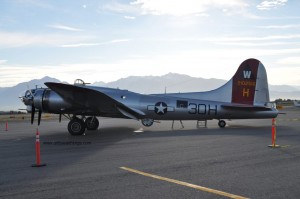
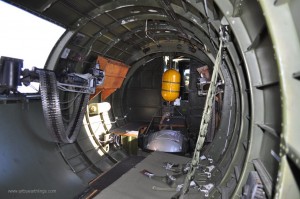
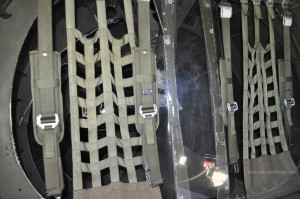
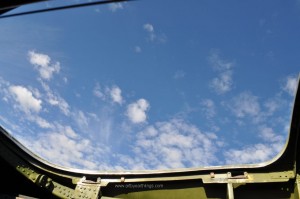
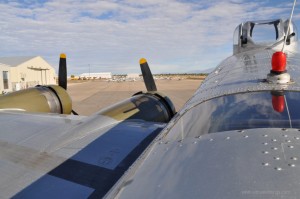
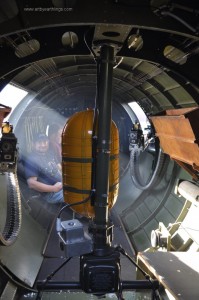
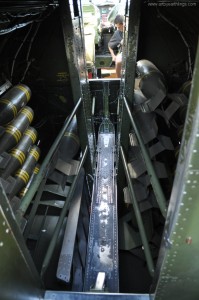
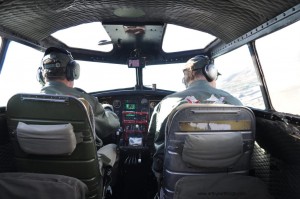
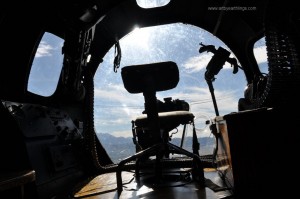
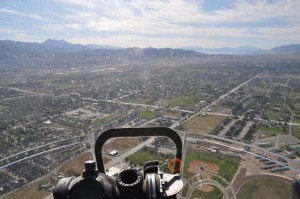

ABSOLUTELY GORGEOUS!!!!
Wow, that sounds awesome! Thanks for sharing!
Neato!
Heya, Scott!
Congrats on taking the flight and thanx for the nice pictures! Also, thank you for supporting a noble cause like keeping the old bird in the air. although a ride isn’t exactly cheap, it takes a lot of money to maintain something like this and your contribution goes to a worthy caude (sorry if I’m speaking like a typical museum guy, but it’s true!).
You said – “the $425 price tag is just a bit steep, and impossible to justify. Oh well”
A B-17 costs several thousand an hour to operate, I dont have the exact figures in front of me, but I can get them. If I remeber right its somewhere around $5K and hour, a big part of that being fuel. Also, but not limited to, insurance, maintenence, parts, oil..etc So, they have to make some profit, for obvious reasons.
I don’t begrudge them the price, it’s just that a year ago it was beyond my means. A week ago it was still beyond my means, but I had some financial support for this particular endeavor.
What struck me most on my flight were the control cables. The control cables on a B-17 run along the inside of the fuselage, and are visible to anyone aboard. You can watch them twitch as the pilot operates the aircraft.
I wonder if during wartime some of the gunners figured out which cable did what, and would watch them waiting for the rudder turn that would take them back to England.
Be nice to see a bunch of old warbirds dumping silver nitrate into storm-clouds, stormfury style, to keep them in service.
It’s interesting you should note the lack of wind on your camera. I think what you were seeing was a tangible indication of the boundary layer around the plane, as illustrated by the effect of wind pressure on your camera. The boundary layer is the region in which the relative flow speed goes from approximately 0 at the skin to whatever the flight speed is. The boundary layer should be a few inches thick (depending on things like air viscosity and distance back on the plane), and you’d perceive this difference in relative flow speed through the different dynamic pressure created by the air on your camera.
This is also why pitot tubes are stuck out away from the plane, to get them out of the boundary layer and into free-stream air where they can get meaningful readings.
So, just how thick was the boundary layer there? Can you estimate, in inches?
N.S. Norway, AKA Nevil Shute, wrote of walking along the top of R-100 in flight, and IIRC, said you could lay a piece of paper down and it would stay there, but if you stood up straight you could feel the full 70-knot breeze.
> just how thick was the boundary layer there? Can you estimate, in inches?
Thin enough that a Nikon D5000 camera could not be projected far enough upwards to take a forward-facing photograph. Less than two inches, closer to one.
Thanks for sharing that. Couldn’t happen to a nicer guy.
Well, conceivably it could happen to a nicer guy, but I can’t imagine it happening to any guy who would appreciate the experience more than you.
I’m holding out for a zeppelin ride, but I wouldn’t mind at all trying a B-17 on for size.
On the other hand, the Liberty Belle landed in a cornfield and burned not far from Fermilab last summer, which might give one pause.
Thanks for sharing those photos.
I was able to visit the Memphis Belle when it was still on display on Mud Island back in ’99.
Unfortunately, the insides of the plane was off limits. SO the best I could do was to take blind shots of the inside by sticking my arm in and snapping pictures using my non-digital camera. When I developed the film, all I got was a wasted roll of film filled with green blurry images. 🙂